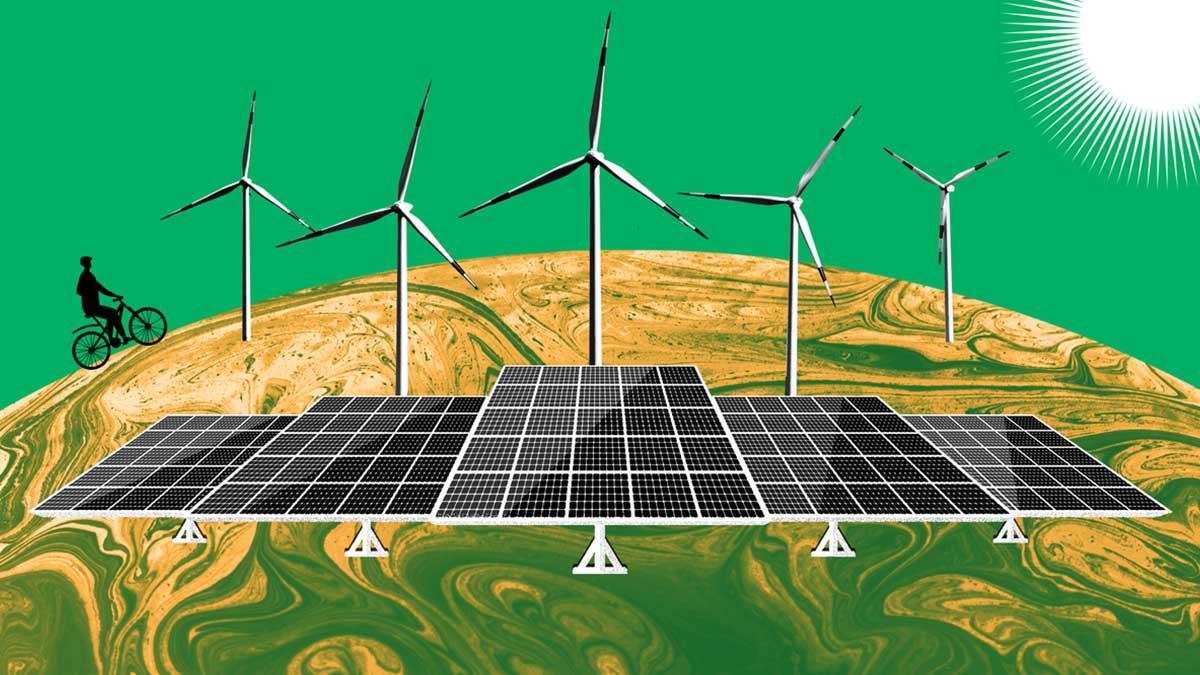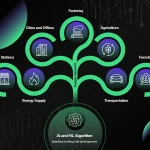Renewable energy solutions offer a promising path towards a more sustainable and environmentally friendly future. By harnessing sources such as solar energy, wind energy, geothermal energy, hydropower, ocean energy, and bioenergy, we can reduce our reliance on fossil fuels and decrease greenhouse gas emissions. The transition to renewable energy is crucial in addressing the pressing climate crisis, as it not only provides cleaner alternatives but also creates more job opportunities and helps mitigate the harmful effects of burning fossil fuels. In this article, we will explore the various renewable energy solutions available and their benefits in creating a cleaner, greener future for generations to come.
Understanding Renewable Energy Sources
The Basics of Solar Power
Solar power is a renewable energy source that harnesses the energy from the sun to generate electricity, heat, and fuels. It is a versatile option that can be utilized even in cloudy weather conditions. The cost of manufacturing solar panels has significantly decreased in recent years, making solar energy an affordable and environmentally friendly choice for many countries.
Wind Energy: Onshore and Offshore Solutions
Wind energy utilizes the kinetic energy of moving air to generate electricity through onshore and offshore wind turbines. The world’s technical potential for wind energy exceeds global electricity production, highlighting its vast untapped potential for clean energy generation. Hitachi Energy products play a significant role in connecting offshore wind farms to onshore grids, addressing challenges in onshore wind project development.

Harnessing the Power of Water: Hydropower
Hydropower is the largest source of renewable energy in the electricity sector, harnessing the energy of water moving from higher to lower elevations through reservoirs and rivers. While it is a reliable source of energy, its infrastructure can have adverse impacts on ecosystems.
Geothermal Energy: Earth’s Natural Heat
Geothermal energy utilizes the Earth’s natural heat to generate electricity. It is a mature and reliable technology that has been in operation for over a century, offering a consistent and renewable energy source that can contribute to reducing environmental impact and ensuring energy security.
Exploring Ocean Energy
Ocean energy, derived from the kinetic and thermal energy of seawater, is still in the early stages of development but has the potential to exceed present human energy requirements. It presents an exciting opportunity for exploring additional renewable energy sources and contributes to a cleaner and more sustainable energy future.
The Role of Bioenergy in Renewable Solutions
Bioenergy, produced from organic materials like biomass, offers a renewable alternative for heat and power production with lower greenhouse gas emissions compared to fossil fuels. However, careful consideration must be given to potential negative environmental impacts related to large-scale bioenergy plantations and deforestation.
The Benefits of Transitioning to Renewable Energy
Reducing Greenhouse Gas Emissions
Transitioning to renewable energy plays a crucial role in reducing greenhouse gas emissions, which are major contributors to climate change. By shifting away from fossil fuels and embracing clean energy sources such as solar and wind power, we can significantly lower our carbon footprint and mitigate the harmful effects of global warming. This transition is essential for creating a sustainable future and ensuring the well-being of our planet for future generations.
Creating Job Opportunities in the Green Economy

The renewable energy sector offers a wealth of job opportunities in the green economy. As the demand for clean energy continues to grow, there is a need for skilled workers in various fields such as engineering, construction, and maintenance. By investing in renewable energy, we not only create employment opportunities but also drive economic growth and prosperity in communities around the world. Transitioning to renewable energy helps to stimulate job creation and build a more sustainable and resilient economy.
Decreasing Reliance on Fossil Fuels
Decreasing our reliance on fossil fuels is crucial for both environmental and economic reasons. Fossil fuels are finite resources that take millions of years to form, making them unsustainable in the long term. By transitioning to renewable energy sources like geothermal and hydropower, we can reduce our dependence on fossil fuels and ensure a more stable and secure energy future. This shift towards clean energy sources not only helps to protect the environment but also safeguards our energy security and independence.
Promoting Sustainable Energy for Future Generations
Promoting sustainable energy practices is vital for ensuring a greener and more sustainable future for generations to come. Renewable energy technologies such as ocean energy and bioenergy offer clean and reliable sources of power that can meet the energy needs of future generations without compromising the health of the planet. By embracing sustainable energy solutions, we can create a more sustainable energy system that prioritizes environmental protection and conservation, paving the way for a brighter future for all.
The Role of Policy and Infrastructure in Supporting Renewable Energy
Government Policies and Incentives
Government policies and incentives are instrumental in driving the transition to renewable energy sources. By implementing regulations that promote the development and utilization of clean energy, governments can create a conducive environment for investment and innovation in the sector. Incentives such as tax credits, grants, and subsidies play a vital role in making renewable energy more financially competitive with traditional fossil fuels. Additionally, setting renewable energy targets and mandating the use of clean energy sources can expedite the shift towards sustainability and reduce reliance on fossil fuels.
Building the Infrastructure for Renewable Energy
Developing the necessary infrastructure is crucial for the widespread integration of renewable energy sources into the existing energy grid. This includes upgrading transmission lines, storage facilities, and distribution networks to ensure the reliable and efficient delivery of clean energy to consumers. Investing in renewable energy infrastructure helps address challenges such as intermittent energy production, ensuring a stable and secure energy supply. Strategic planning and investment in infrastructure can unlock the full potential of clean energy sources, leading to enhanced energy security and independence.
International Cooperation in Renewable Energy Development
International collaboration plays a pivotal role in advancing renewable energy development on a global scale. By partnering with other countries, knowledge, resources, and best practices in renewable energy technology and policy can be shared. Collaborative efforts enable countries to tackle common obstacles such as financing renewable energy projects and navigating regulatory hurdles. Furthermore, international cooperation allows countries to leverage each other’s strengths and expertise, accelerating the transition towards a sustainable and low-carbon energy system. By fostering partnerships at the international level, countries can collectively drive progress towards a cleaner and more resilient energy future for all.
Renewable energy projects have seen significant success worldwide, showcasing the benefits of transitioning from fossil fuels to sustainable sources. Let’s explore some of the remarkable case studies that highlight the achievements in the renewable energy sector.
Solar Power Success Stories
Solar power has emerged as a leading success story in the renewable energy landscape. The abundance of sunlight and advancements in solar technology have made it a viable and environmentally friendly option for generating electricity. The plummeting cost of manufacturing solar panels has made them more accessible, enabling individuals and businesses to harness clean energy from the sun.
Wind Energy Triumphs

Advancements in onshore and offshore wind technologies have propelled wind energy triumphs globally. With the ability to maximize electricity production, wind farms have become a significant contributor to the renewable energy mix. The reliability and scalability of wind energy make it a key player in the transition towards a sustainable energy future.
Hydropower Achievements
Hydropower projects have demonstrated the importance of harnessing the energy of moving water to generate electricity. While hydropower offers a reliable and renewable energy source, the infrastructure required can have adverse impacts on ecosystems. Despite these challenges, hydropower remains a crucial component of the renewable energy portfolio in many countries.
Innovative Geothermal Projects
Geothermal energy utilizes the Earth’s thermal energy to generate electricity, showcasing mature technology that has been in operation for over a century. By tapping into the heat beneath the Earth’s surface, geothermal projects provide a consistent and sustainable source of power. The development of innovative geothermal technologies continues to expand the potential of this renewable energy source.
Bioenergy Implementation Examples
Bioenergy projects demonstrate the use of organic materials for heat and power production, catering to the energy needs of rural communities and developing countries. While bioenergy offers a lower carbon footprint compared to fossil fuels, caution is advised to prevent negative environmental impacts. The implementation of bioenergy projects highlights the importance of diversifying the energy mix and promoting sustainability in the energy sector.
Looking Ahead: The Future of Renewable Energy
Emerging Trends in Renewable Energy
The future of renewable energy is promising, with emerging trends shaping the landscape of sustainable power generation. Solar energy, derived from the sun’s radiation, has seen significant advancements in technology, making it a cost-effective option for electricity production. Similarly, wind energy, harnessed through turbines onshore and offshore, has the potential to surpass global electricity production. These trends highlight the shift towards cleaner and more sustainable energy sources to combat climate change.
The Increasing Importance of Energy Storage
Energy storage is becoming increasingly vital in the renewable energy sector to ensure efficient distribution and utilization of power generated from natural sources. Technologies like geothermal energy, hydropower, and ocean energy are gaining traction for their ability to harness renewable resources effectively. However, the focus on energy storage solutions is crucial to maintain system stability and meet fluctuating energy demands in a sustainable manner.
Future Challenges and Opportunities
While the potential of renewable energy is vast, there are challenges that need to be addressed for its widespread adoption. Climate-induced factors like droughts and ecosystem changes can impact renewable sources like hydropower, necessitating sustainable practices and innovative technologies. Balancing energy production with environmental conservation is key to ensuring a brighter and safer future powered by renewables. By investing in sustainable solutions and overcoming challenges, the transition from fossil fuels to renewable energy can pave the way for a more sustainable energy system beneficial to both the environment and society.
conclusion
In conclusion, renewable energy solutions offer a promising alternative to traditional fossil fuels, providing a sustainable and environmentally friendly way to meet our energy needs. From harnessing solar power to exploring ocean energy, the possibilities for renewable energy sources are vast and continually evolving. Transitioning to renewable energy not only helps reduce greenhouse gas emissions but also creates a more resilient and reliable energy system for the future. However, challenges such as integrating renewable energy into existing infrastructure and addressing the fluctuating nature of some renewable sources must be overcome. Government policies and incentives play a crucial role in driving the transition to renewable energy, as seen in successful projects worldwide that showcase the benefits of sustainable energy solutions. Looking ahead, emerging trends in renewable energy offer exciting opportunities for innovation and growth in the sector. While there are still challenges to address, the future of renewable energy looks bright, with the potential to revolutionize the way we power our world. By embracing renewable energy solutions, we can pave the way for a more sustainable and prosperous future for all.









